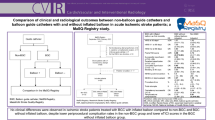Abstract
Background
For endovascular treatment of vasospasm after aneurysmal subarachnoid hemorrhage (aSAH), an intraarterial treatment course with the calcium channel antagonist nimodipine infused for 30 min is proposed. As some patients still show ongoing vasospasm thereafter, we report on our experience with an extended time period of selective intraarterial nimodipine administration.
Methods
In nine patients with aSAH and refractory cerebral vasospasm, we left the catheter in place within the internal carotid artery after angiography. On the neurosurgical ICU, a continuous infusion of intraarterial nimodipine was commenced, combined with intraarterial heparin anticoagulation. Therapy was controlled with extended neuromonitoring techniques.
Results
Three patients died from refractory vasospasm and a fourth suffered lethal sepsis. Three patients survived in a good clinical condition, two of them without apparent neurologic deficit. The efficacy of intraarterial nimodipine was best verified with regional CBF monitoring. TCD failed to detect vasospasm in two patients and missed improvement in four. Brain tissue oxygenation increased in all patients, but was not indicative of vasospasm in one. CT perfusion reflected the treatment course adequately in the qualitative scans.
Conclusion
Selective continuous intraarterial nimodipine treatment for refractory cerebral vasospasm after aSAH seems feasible and may add to the endovascular therapeutic options. Appropriate monitoring technology is essential for further investigation of this novel technique.



Similar content being viewed by others
References
Pluta RM, Hansen-Schwartz J, Dreier J, Vajkoczy P, Macdonald RL, Nishizawa S, et al. Cerebral vasospasm following subarachnoid hemorrhage: time for a new world of thought. Neurol Res. 2009;31:151–8.
Brisman JL, Eskridge JM, Newell DW. Neurointerventional treatment of vasospasm. Neurol Res. 2006;28:769–76.
Milburn JM, Moran CJ, Cross DT III, Diringer MN, Pilgram TK, Dacey RG Jr. Increase in diameters of vasospastic intracranial arteries by intraarterial papaverine administration. J Neurosurg. 1998;88:38–42.
Pluta RM, Afshar JK, Thompson BG, Boock RJ, Harvey-White J, Oldfield EH. Increased cerebral blood flow but no reversal or prevention of vasospasm in response to l-arginine infusion after subarachnoid hemorrhage. J Neurosurg. 2000;92:121–6.
Yoshida K, Watanabe H, Nakamura S. Intraarterial injection of amrinone for vasospasm induced by subarachnoid hemorrhage. AJNR Am J Neuroradiol. 1997;18:492–6.
Suzuki S, Ito O, Sayama T, Yamaguchi S, Goto K, Sasaki T. Intraarterial injection of colforsin daropate hydrochloride for the treatment of vasospasm after aneurysmal subarachnoid hemorrhage: preliminary report of two cases. Neuroradiology. 2006;48:50–3.
Biondi A, Ricciardi GK, Puybasset L, Abdennour L, Longo M, Chiras J, et al. Intra-arterial nimodipine for the treatment of symptomatic cerebral vasospasm after aneurysmal subarachnoid hemorrhage: preliminary results. AJNR Am J Neuroradiol. 2004;25:1067–76.
Badjatia N, Topcuoglu MA, Pryor JC, Rabinov JD, Ogilvy CS, Carter BS, et al. Preliminary experience with intra-arterial nicardipine as a treatment for cerebral vasospasm. AJNR Am J Neuroradiol. 2004;25:819–26.
Feng L, Fitzsimmons BF, Young WL, Berman MF, Lin E, Aagaard BD, et al. Intraarterially administered verapamil as adjunct therapy for cerebral vasospasm: safety and 2-year experience. AJNR Am J Neuroradiol. 2002;23:1284–90.
Liu JK, Couldwell WT. Intra-arterial papaverine infusions for the treatment of cerebral vasospasm induced by aneurysmal subarachnoid hemorrhage. Neurocrit Care. 2005;2:124–32.
Mayer TE, Dichgans M, Straube A, Birnbaum T, Muller-Schunk S, Hamann GF, et al. Continuous intra-arterial nimodipine for the treatment of cerebral vasospasm. Cardiovasc Intervent Radiol. 2008;31:1200–4.
Lysakowski C, Walder B, Costanza MC, Tramer MR. Transcranial Doppler versus angiography in patients with vasospasm due to a ruptured cerebral aneurysm: a systematic review. Stroke. 2001;32:2292–8.
Hanggi D, Turowski B, Beseoglu K, Yong M, Steiger HJ. Intra-arterial nimodipine for severe cerebral vasospasm after aneurysmal subarachnoid hemorrhage: influence on clinical course and cerebral perfusion. AJNR Am J Neuroradiol. 2008;29:1053–60.
Vajkoczy P, Roth H, Horn P, Lucke T, Thome C, Hubner U, et al. Continuous monitoring of regional cerebral blood flow: experimental and clinical validation of a novel thermal diffusion microprobe. J Neurosurg. 2000;93:265–74.
Vajkoczy P, Horn P, Bauhuf C, Munch E, Hubner U, Ing D, et al. Effect of intra-arterial papaverine on regional cerebral blood flow in hemodynamically relevant cerebral vasospasm. Stroke. 2001;32:498–505.
Muench E, Horn P, Bauhuf C, Roth H, Philipps M, Hermann P, et al. Effects of hypervolemia and hypertension on regional cerebral blood flow, intracranial pressure, and brain tissue oxygenation after subarachnoid hemorrhage. Crit Care Med. 2007;35:1844–51.
Raabe A, Beck J, Keller M, Vatter H, Zimmermann M, Seifert V. Relative importance of hypertension compared with hypervolemia for increasing cerebral oxygenation in patients with cerebral vasospasm after subarachnoid hemorrhage. J Neurosurg. 2005;103:974–81.
Hoelper BM, Hofmann E, Sporleder R, Soldner F, Behr R. Transluminal balloon angioplasty improves brain tissue oxygenation and metabolism in severe vasospasm after aneurysmal subarachnoid hemorrhage: case report. Neurosurgery. 2003;52:970–4.
Stiefel MF, Spiotta AM, Udoetuk JD, Maloney-Wilensky E, Weigele JB, Hurst RW, et al. Intra-arterial papaverine used to treat cerebral vasospasm reduces brain oxygen. Neurocrit Care. 2006;4:113–8.
Liu JK, Tenner MS, Gottfried ON, Stevens EA, Rosenow JM, Madan N, et al. Efficacy of multiple intraarterial papaverine infusions for improvement in cerebral circulation time in patients with recurrent cerebral vasospasm. J Neurosurg. 2004;100:414–21.
Majoie CB, van Boven LJ, van de BD, Venema HW, van Rooij WJ. Perfusion CT to evaluate the effect of transluminal angioplasty on cerebral perfusion in the treatment of vasospasm after subarachnoid hemorrhage. Neurocrit Care. 2007;6:40–4.
Moftakhar R, Rowley HA, Turk A, Niemann DB, Kienitz BA, Van Gomple J, et al. Utility of computed tomography perfusion in detection of cerebral vasospasm in patients with subarachnoid hemorrhage. Neurosurg Focus. 2006;21:E6.
Hunt WE, Hess RM. Surgical risk as related to time of intervention in the repair of intracranial aneurysms. J Neurosurg. 1968;28:14–20.
Fisher CM, Kistler JP, Davis JM. Relation of cerebral vasospasm to subarachnoid hemorrhage visualized by computerized tomographic scanning. Neurosurgery. 1980;6:1–9.
Jennett B, Bond M. Assessment of outcome after severe brain damage. Lancet. 1975;1:480–484.
Author information
Authors and Affiliations
Corresponding author
Rights and permissions
About this article
Cite this article
Wolf, S., Martin, H., Landscheidt, J.F. et al. Continuous Selective Intraarterial Infusion of Nimodipine for Therapy of Refractory Cerebral Vasospasm. Neurocrit Care 12, 346–351 (2010). https://doi.org/10.1007/s12028-009-9317-6
Published:
Issue Date:
DOI: https://doi.org/10.1007/s12028-009-9317-6




